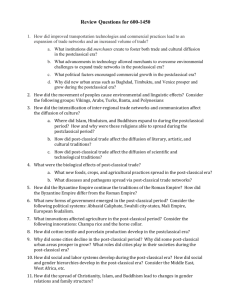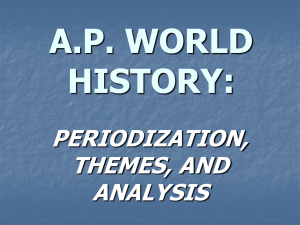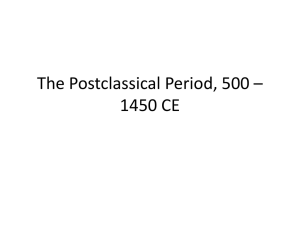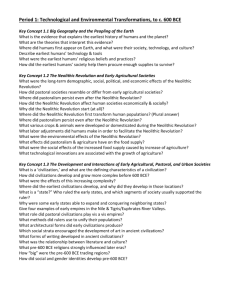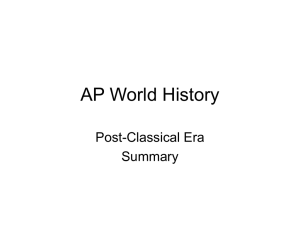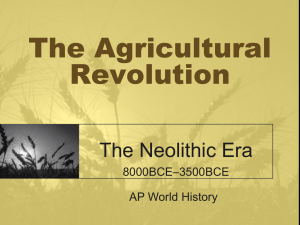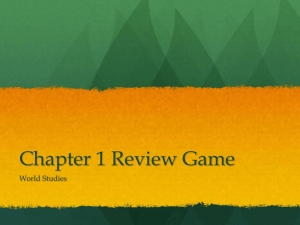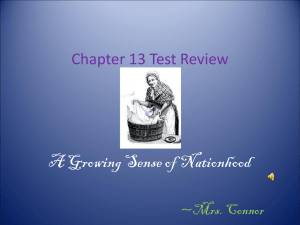Period Project
advertisement
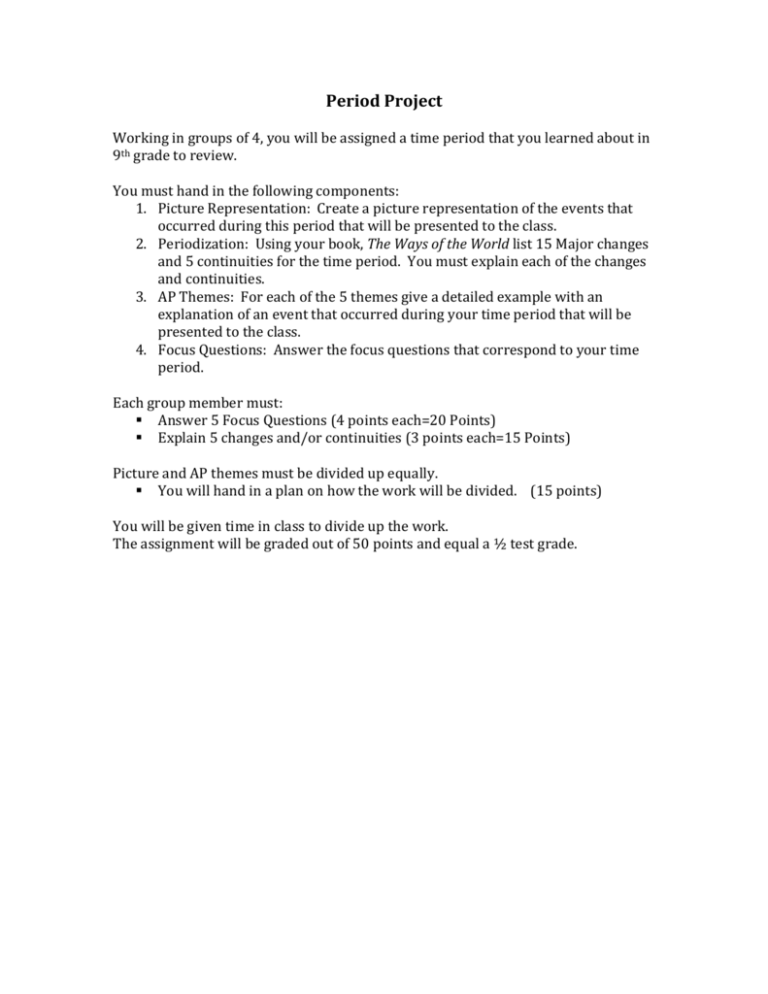
Period Project Working in groups of 4, you will be assigned a time period that you learned about in 9th grade to review. You must hand in the following components: 1. Picture Representation: Create a picture representation of the events that occurred during this period that will be presented to the class. 2. Periodization: Using your book, The Ways of the World list 15 Major changes and 5 continuities for the time period. You must explain each of the changes and continuities. 3. AP Themes: For each of the 5 themes give a detailed example with an explanation of an event that occurred during your time period that will be presented to the class. 4. Focus Questions: Answer the focus questions that correspond to your time period. Each group member must: Answer 5 Focus Questions (4 points each=20 Points) Explain 5 changes and/or continuities (3 points each=15 Points) Picture and AP themes must be divided up equally. You will hand in a plan on how the work will be divided. (15 points) You will be given time in class to divide up the work. The assignment will be graded out of 50 points and equal a ½ test grade. Period One: Technological & Environmental Transformations: 8000 BCE to 600 BCE 1. Where did humans first appear on Earth, and what were the characteristics of their society, technology, economy and culture? 2. How did the earliest humans’ society help them procure enough supplies to survive? 3. What were the long-term demographic, social, political and economic effects of the Neolithic Revolution? 4. Compare and contrast pastoral societies from early agricultural societies? 5. How did the Neolithic Revolution affect human societies economically and socially? 6. Where did the Neolithic Revolution first transform human populations? 7. Where did pastoralism persist during this time period? 8. What crops and animals were developed or domesticated during the Neolithic Revolution? 9. What were the environmental effects of the Neolithic Revolution? 10. What effects did pastoralism and agriculture have on the food supply? 11. What technological innovations are associated with the growth of agriculture? 12. What is a “civilization” and what are the defining characteristics of a civilization? 13. Where did the earliest civilizations develop and why did they develop in those locations? 14. What is a “state”? Who ruled the early states? 15. Why were some early states able to expand and conqueror neighboring states? 16. Give four examples of early empires in the Nile and Tigris/Euphrates River Valleys? 17. How did culture play a role in unifying populations? 18. What architectural forms did the early civilizations produce? 19. What pre-600 BCE religions strongly influence later eras? 20. How “big” were the pre 600 BCE trading regions? 21. How did social and gender identities develop pre-600 BCE? Period Two: Organization & Reorganization of Human Societies: 600 BCE-600CE 1. How did religions help strengthen political, economic and cultural tied within societies? 2. What are the characteristics and core teachings of Judaism? 3. What are the characteristics and core teachings of Hinduism? 4. What are the characteristics and core teachings of Buddhism? 5. How and where did Buddhism spread by 600 CE? 6. What are the characteristics and core teachings of Confucianism? 7. What are the characteristics and core teachings of Daoism? 8. What are the characteristics and core teachings of Christianity? 9. How and where did Christianity spread by 600 CE? 10. What are the main characteristics of Greco-Roman philosophy and science? 11. How did religions affect gender roles in their societies? 12. How did art and culture develop to 600 CE? 13. What examples of syncretism reflect the Classical Era to 600 CE? 14. What is an “empire,” and what were empires’ common characteristics during the Classical Era? 15. What techniques did Classical empires create to administer their territories? 16. What was commonly traded along trade networks and what role did trade play in creating and maintaining empires? 17. How did technology enable long distance overland and maritime trade? 18. What social classes were common in empires and what labor systems provided for workers in the Classical Empires? 19. Describe the gender and family structures of Classical Era Empires? 20. What caused Classical Empires to decline or collapse? 21. What effects did diseases have on Classical Empires? Period Three: Regional & Transregional Interactions: 600-1450 CE 1. What Classical era trade networks continued during the post-classical era, and which new cities were added during the post-Classical era? 2. What new technologies, governmental policies ad merchant activities accompany these developments? 3. What role did pastoral and nomadic groups play in these trade networks? 4. What new technologies enabled the growth of interregional trade networks? 5. What were the effects of migration in the post-classical era? 6. What were the linguistic effects of migration in the post-classical era? 7. What institutions did merchants create to foster both trade and cultural diffusion in the post-classical era? 8. Hoe did Muslim trade networks change in the post-classical era? 9. How did post-classical trade affect the diffusion of literary, artistic, and cultural traditions? 10. How did post-classical trade affect the diffusion of scientific and technological traditions? 11. What new foods, crops, and agricultural practices diffused in the postclassical era? 12. How did textile and porcelain production develop in the post-classical era? 13. What diseases and pathogens also spread along the post-classical trade networks? 14. What new forms of governance emerged in the post-classical era? 15. How did 16. Why did some post-classical urban area declined, while some grew and prospered? 17. What pre-existing labor systems continued through the post-classical era? 18. What roles did cities play in their societies? 19. How did social and labor systems develop during the post-classical era? 20. How did social and gender hierarchies develop in the post-classical era? Period Four: Global Interactions : 1450-1750 1. Describe the degree of global “interconnection” after 1500 CE compared to before 1500. 2. How did the global trade network after 1500 affect the pre-existing regional trade networks? (Indian Ocean, Mediterranean, trans-Saharan, Silk Routes) 3. What technical developments made transoceanic European travel and trade possible? 4. Where did Zheng He and the Chinese Treasure ships travel? 5. Why did Portugal begin longer maritime voyages circa 1430CE? 6. What effects did Columbus’ travels have on Europeans? 7. What originally motivated Europeans to travel across the northern Atlantic? 8. What role did silver play in facilitating a truly global scale of trade? 9. What new mercantilist financial means developed to facilitate global trade? 10. What were the economic ad social effects of the Atlantic trading system? 11. What plants and animals were transferred across the Atlantic as part of the Columbian Exchange? 12. Where and why did the “universal” religions of Buddhism, Christianity and Islam spread? 13. How did public literacy as well as literary and artistic forms of expression develop during this period? 14. How did slavery compare to the pre 1450 era? 15. How was peasant labor affected between 1450-1750? 16. How did labor systems develop in the colonial Americas? 17. How did the post-1450 economic order restructure the social, economic and political elites? 18. How were gender and family structures affected by these changes? 19. How did empires attempt to administer the new widespread nature of their territories? 20. What role did religion play in political rule? 21. How were ethnic and religious minorities treated in various empires? 22. What obstacles to empire building did empires confront and how did they respond to these challenges?
